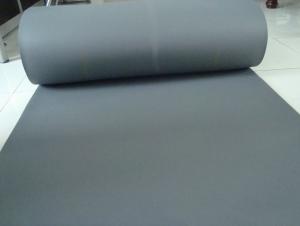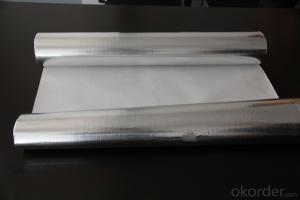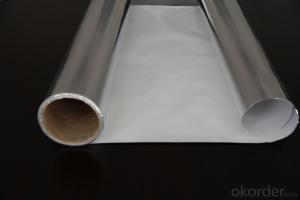Aluminum Foil Facing FSK Insulation for Roofing Wall Vapor Barrier
- Loading Port:
- Shanghai
- Payment Terms:
- TT OR LC
- Min Order Qty:
- 200 m²
- Supply Capability:
- 6000000 m²/month
OKorder Service Pledge
OKorder Financial Service
You Might Also Like
1. Aluminum Foil Facing Description:
The aluminum foil facing, whose structure is white polypropylene/ fiberglass scrim/ kraft is mainly used for metal building insulation and suitable for the insulation of ware-house, factory, supermarket, office and suitable for off-line lamination of glass wool or rock wool.
2.Main Features of the Aluminum foil facing:
• Light weight
• Small inertia resistance
• High manufacturing accuracy
• Strong heat dissipation ability
• Good visual effect
• environmentally friendly,no smell and not-toxic;
• Smooth and clear surface;
3.Aluminum Foil Facing Images


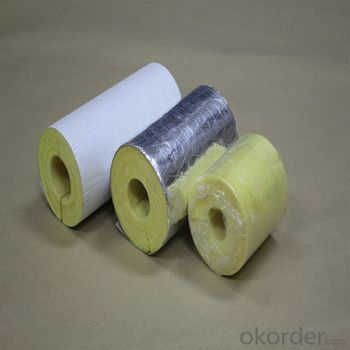
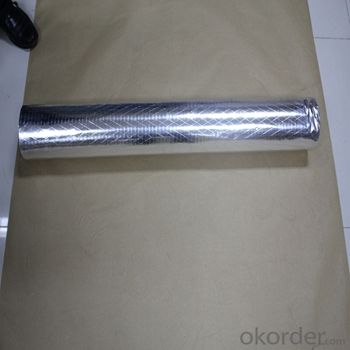
4.Aluminum Foil Facing Specification
Width: 1.0m, 1.2m, 1.25 m, 1.30, 1.37m
Length: 200m, 500m, 1000m, 2500m, 2750m, 3300m
Core I.D.: 3"(76mm ±1), 72mm ±1
Based on order, special sizes are also available.
5.FAQ
What is the storage condition?
The products should be stored at room temperature and kept from wet and heat source.
It is essential, as with all pressure-sensitive tapes, that the surface to which the tape is applied must be clean, dry, and free of grease and oil.
The user should take test and do trial-application on the above products before coming into application so as to witness and ensure suitability for user’s special purpose and technique.
- Q: What are the recommended cleaning products for aluminum foil facing after use?
- <p>For cleaning aluminum foil facing after use, it's best to use gentle, non-abrasive cleaning products. Mild dish soap and warm water are usually sufficient for most cleaning needs. Avoid using harsh chemicals or abrasive scrubbers, as they can damage the aluminum surface. If there are stubborn stains, a mixture of baking soda and water can be used as a gentle abrasive. Always rinse thoroughly and dry the surface to prevent any residue or potential damage.</p>
- Q: This question asks about the proper way to store aluminum foil to keep it facing the right way for easy use.
- <p>To store aluminum foil facing the right way, first use up one side completely. Then, fold the remaining foil in half with the shiny side facing out. Place the folded foil back into the box or container, shiny side up. When you need to use it next, the shiny side will be facing you, making it easy to tear off. To keep it flat and wrinkle-free, you can place a piece of cardboard inside the box, or roll it around a clean, empty paper towel tube.</p>
- Q: How should aluminum foil be stored after it has been used for cooking or food storage to keep it clean and ready for future use?
- <p>The best ways to store aluminum foil facing after using it for cooking or food storage involve cleaning and organizing it properly. First, wash the used foil with warm soapy water to remove any food residue. Rinse it thoroughly and pat dry with a clean towel. To store, roll the foil tightly starting from the center, keeping it compact and neat. Alternatively, you can store it in a resealable plastic bag or a dedicated foil container to keep it clean and prevent it from tearing. Always store it in a cool, dry place away from direct sunlight to maintain its quality.</p>
- Q: This question asks about potential health hazards linked to consuming food that has been wrapped in aluminum foil.
- <p>There are minimal health risks associated with eating food wrapped in aluminum foil. Aluminum foil is generally safe for cooking and food storage. However, it's important to avoid wrapping acidic or high-sodium foods in aluminum foil, as these can cause the foil to corrode and potentially release small amounts of aluminum. Long-term consumption of aluminum in large quantities has been linked to rare health issues, such as Alzheimer's disease, though this link is not definitively proven. To be safe, use aluminum foil sparingly and avoid wrapping foods that are highly acidic or salty.</p>
- Q: Is it safe or practical to use aluminum foil facing as a material for making soup?
- <p>No, it is not advisable to use aluminum foil facing for making soup. Aluminum foil is not designed for direct contact with food, especially when heated, as it can potentially leach aluminum into the food. Additionally, aluminum foil is not a suitable material for cooking vessels as it can tear or puncture easily, leading to safety hazards. Instead, use materials specifically designed for cooking, such as stainless steel, ceramic, or glass cookware, which are safe and non-reactive with food.</p>
- Q: This question asks for advice on how to use aluminum foil effectively in the kitchen.
- <p>Using aluminum foil efficiently in the kitchen can save time and resources. Here are some tips: 1. Pre-cut and store: Keep a roll of aluminum foil in the kitchen and pre-cut pieces for quick use. 2. Double layer for insulation: Use a double layer for wrapping food to retain heat and keep food warm for longer. 3. Line baking sheets: Line baking sheets with foil to prevent sticking and make cleanup easier. 4. Cover dishes: Use foil to cover dishes in the oven to prevent over-browning. 5. Use for grilling: Wrap vegetables or fish in foil for easy, mess-free grilling. 6. Reuse: Reuse aluminum foil for multiple tasks to minimize waste. 7. Avoid overuse: Use only as much foil as needed to prevent unnecessary waste. 8. Recycle: Always recycle aluminum foil after use to contribute to sustainability.</p>
- Q: Explain the distinction between aluminum foil insulation with and without a vapor barrier.
- <p>Aluminum foil insulation with a vapor barrier is designed to prevent moisture from passing through, which is crucial in humid environments to prevent condensation and mold growth. The vapor barrier is a layer that acts as a moisture control, enhancing the insulation's effectiveness. On the other hand, aluminum foil without a vapor barrier does not have this moisture-resistant layer, making it less effective in controlling moisture and potentially leading to condensation issues. The presence of a vapor barrier can also impact the thermal performance and energy efficiency of the insulation.</p>
- Q: Is it possible to use aluminum foil with a reflective side facing up for cooking or frying food?
- <p>Using aluminum foil with a reflective side facing up for frying food is not recommended. Aluminum foil is not designed for direct contact with high heat sources like frying pans or oil. It can cause uneven heating, stick to the food, and potentially release harmful aluminum particles into the food. For safe and effective cooking, use appropriate cookware designed for high heat and direct contact with food.</p>
- Q: Can aluminum foil be utilized as a surface for cooking pancakes?
- <p>While it's technically possible to cook pancakes on aluminum foil, it's not recommended. Aluminum foil can stick to the pancakes, making them difficult to flip and remove without breaking. It also conducts heat unevenly, leading to uneven cooking. Instead, use a non-stick pan or a griddle for the best results. If you must use foil, consider greasing it heavily and using a thin layer to minimize sticking and ensure even heat distribution.</p>
- Q: Is it possible to use aluminum foil with a reflective side to construct a sandwich?
- <p>While it's technically possible to use aluminum foil facing to make a sandwich, it's not recommended. Aluminum foil is not designed for direct food contact, especially the reflective side which may contain harmful substances that could leach into the food. Instead, use the dull side of the foil or better yet, use food-safe wrap or containers for preparing and storing sandwiches.</p>
Send your message to us
Aluminum Foil Facing FSK Insulation for Roofing Wall Vapor Barrier
- Loading Port:
- Shanghai
- Payment Terms:
- TT OR LC
- Min Order Qty:
- 200 m²
- Supply Capability:
- 6000000 m²/month
OKorder Service Pledge
OKorder Financial Service
Similar products
Hot products
Hot Searches
Related keywords










